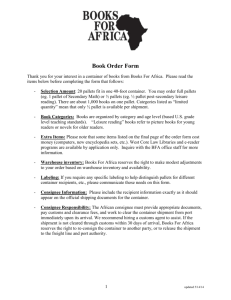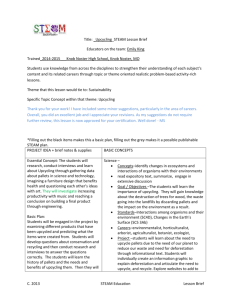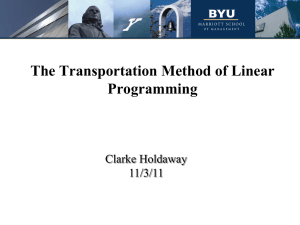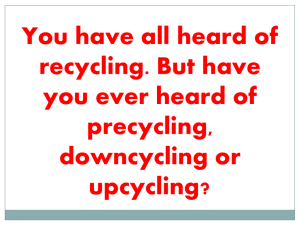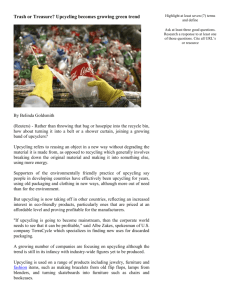6Title: _Upcycling_STEAM Lesson Brief Educators on the team: (for
advertisement
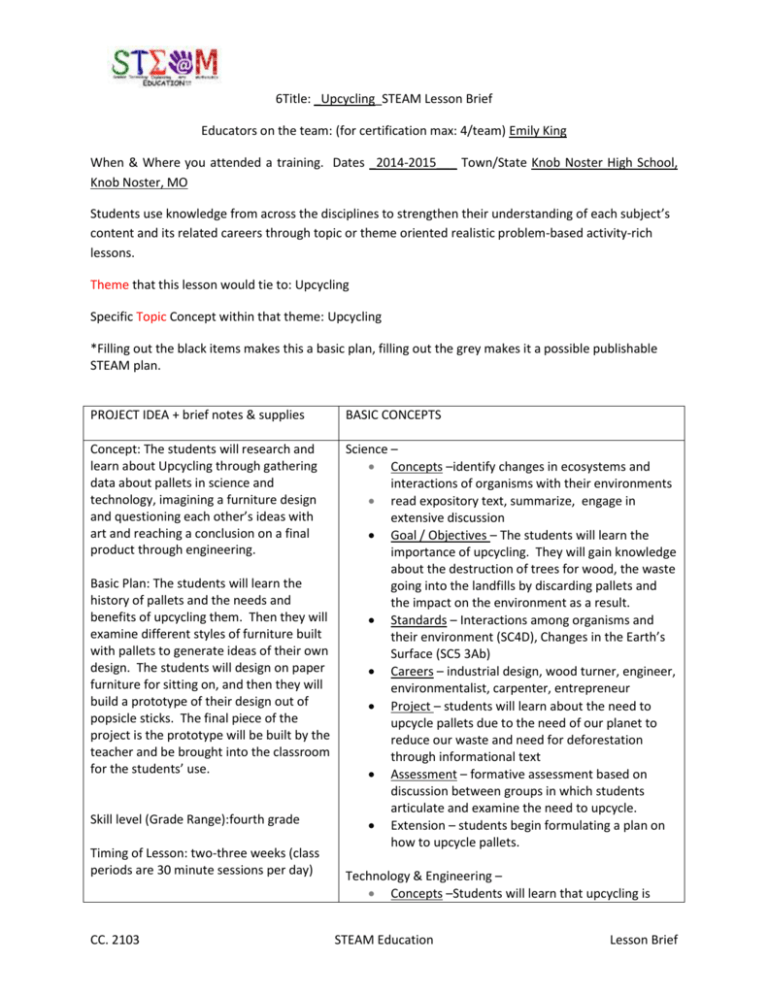
6Title: _Upcycling_STEAM Lesson Brief Educators on the team: (for certification max: 4/team) Emily King When & Where you attended a training. Dates _2014-2015___ Town/State Knob Noster High School, Knob Noster, MO Students use knowledge from across the disciplines to strengthen their understanding of each subject’s content and its related careers through topic or theme oriented realistic problem-based activity-rich lessons. Theme that this lesson would tie to: Upcycling Specific Topic Concept within that theme: Upcycling *Filling out the black items makes this a basic plan, filling out the grey makes it a possible publishable STEAM plan. PROJECT IDEA + brief notes & supplies BASIC CONCEPTS Concept: The students will research and learn about Upcycling through gathering data about pallets in science and technology, imagining a furniture design and questioning each other’s ideas with art and reaching a conclusion on a final product through engineering. Science – Concepts –identify changes in ecosystems and interactions of organisms with their environments read expository text, summarize, engage in extensive discussion Goal / Objectives – The students will learn the importance of upcycling. They will gain knowledge about the destruction of trees for wood, the waste going into the landfills by discarding pallets and the impact on the environment as a result. Standards – Interactions among organisms and their environment (SC4D), Changes in the Earth’s Surface (SC5 3Ab) Careers – industrial design, wood turner, engineer, environmentalist, carpenter, entrepreneur Project – students will learn about the need to upcycle pallets due to the need of our planet to reduce our waste and need for deforestation through informational text Assessment – formative assessment based on discussion between groups in which students articulate and examine the need to upcycle. Extension – students begin formulating a plan on how to upcycle pallets. Basic Plan: The students will learn the history of pallets and the needs and benefits of upcycling them. Then they will examine different styles of furniture built with pallets to generate ideas of their own design. The students will design on paper furniture for sitting on, and then they will build a prototype of their design out of popsicle sticks. The final piece of the project is the prototype will be built by the teacher and be brought into the classroom for the students’ use. Skill level (Grade Range):fourth grade Timing of Lesson: two-three weeks (class periods are 30 minute sessions per day) CC. 2103 Technology & Engineering – Concepts –Students will learn that upcycling is STEAM Education Lesson Brief Basic Supplies: internet access (for information, and music component), popsicle sticks, wood glue, hot glue, sketching paper, pallets and tools necessary to construct design. All Subjects: science, language arts Individual Subjects: science and math Science – Research notes, computer Math- Measurement, proportion IT Resources: websites: Pinterest for pallet furniture examples, http://recycling.about.com/od/Pallet_Rec ycling_Glossary/a/What-Is-A-Pallet.htm (What is a Pallet?), http://www.1001pallets.com/pallet-size/ (Pallet Size), Pandora for music. Other Resources: teachers knowledge on building with pallets Misc: Photos: CC. 2103 reusing discarded objects to create a product of higher quality or value than the original using internet sources. Goal / Objectives - The students will learn the specific characteristics of pallet design. They will learn the specific uses of them in industry which will lend itself to their durable construction and the difficulty of dismantling them for other uses. Standards - Follow an inquiry process to construct new understandings, draw conclusions, and create new knowledge (T1A4) Careers - industrial design, wood turner, engineer, environmentalist, carpenter, entrepreneur Project - The students will find information on what pallets are currently used for, their basic construction and necessary requirements to dismantle them. Then students will begin to formulate a plan of the design prototype based on a more developed understanding of the material they will be working with. Assessment – Students create a design plan upcycling a pallet and identify the need of having initiative to create a new product. Extension - Students will discuss how different styles of pallets may inhibit their design. Math – Concepts –Measure and use proportion to create a scale model. Goal / Objectives – Students will recognize that the prototype is a very small representation of the overall ending project. Measurements of space such as doorways and actual student size is relevant to the project. Standards Know relative sizes of measurement units (4.MD.A.1) Careers - industrial design, wood turner, engineer, environmentalist, carpenter, entrepreneur Project – the student will draw a sketch of their pallet project design. Then the students will work in teams to build a prototype out of popsicle sticks. Assessment – Prototype that is a scale model of students upcycle design that reflets accurate measurements. Extension - Students will be working in teams and will be required to use all team members ideas STEAM Education Lesson Brief and input to complete the project. LA – SS – CC. 2103 Concepts –read expository text, summarize, and carry on discussions Goal / Objectives – the students will read to find information pertaining to pallets, what they are, what they are used for and how they are being upcycled today. Standards – read and comprehend complex literary and informational texts independently and proficiently(R.CCR.10) Speaking and Listening standard-Recount or describe key ideas or details from a text read aloud or information presented orally or through other media(SL.2.2) Speaking and Listening standard -Ask and answer questions about what a speaker says in order to clarify comprehension, gather additional information, or deepen understanding of a topic or issue. (SL.2.3) Careers - industrial design, wood turner, engineer, environmentalist, carpenter, entrepreneur Assessment – formative assessment based on discussion between groups on the understanding of the need to upcycle through observation of conversation between cooperative learning groups and exit tickets. Extension - Begin formulating a plan on how students can upcycle pallets. Concepts –Students will explain why industry so heavily relies on the use of pallets and the impact of their economic design for transporting product more efficiently. Goal / Objectives – the students will gain a better understanding of the industrial uses of pallets and the importance in distribution of products throughout the country as well as the environmental impact of using pallets made of wood. Standards – Understanding the consequences of personal and public and economic decisions (SS4 3.8) Careers - industrial design, wood turner, engineer, environmentalist, carpenter, entrepreneur STEAM Education Lesson Brief Project - - the student will read about the industrial uses of pallets in relation to shipping product and articulate why industry relies on them so heavily. Students will discuss how they might have been shipped in the past for the use of pallets. Assessment formative assessment based on discussion between groups on the understanding of the uses of pallets for shipping purposes and the demand for continual production of pallets to keep up with shipping demands. Students will explain the impact of economic demand. Extension - Work as teams to discuss alternatives to using pallets for shipping and present to group. Art PE – CC. 2103 Concepts- Students will design a piece of furniture made from pallets for use in the classroom. Goal/Objectives: The students will create a design of furniture that can be taken from concept to reality and functionality. Standards- HC1B4 Careers - industrial design, wood turner, engineer, environmentalist, carpenter, entrepreneur Project- The students will examine different furniture designs made from pallets on Pinterest. They will use this foundation to expand their creativity. The students will sketch and then build a prototype of furniture. Students will design a functional piece of furniture. Assessment – The prototype that the students build will be checked for functionality and discussed by the group as a whole. Extension –the students will be required to work as teams to create a final design. Concepts –Proper alignment of spine in creating comfortable and safe furniture. The students will research and identify proper sitting posture. Goal / Objectives – the students will understand that their furniture design must be comfortable and support the spine properly Standards – Prevention (HPE4) Careers - industrial design, wood turner, engineer, environmentalist, carpenter, entrepreneur Project – the students will design a piece of furniture that will be comfortable to sit on their STEAM Education Lesson Brief way. Assessment – The students will build prototypes and as a whole choose which design is the most comfortable to sit on. Students will explain comfort in relation to the proper sitting posture and alignment of the spine. Extension – students will be challenged to add any additional parts to make piece more functional (arm rests, foot rests, ect.) Music – Concepts – the students will work to music to be more productive in a timely manner. The students will describe how music affects their production. Goal / Objectives – The students will be given music from different genres to determine which beat helps them to produce more effectively. Standards – Genres and Styles (MU9) Careers - industrial design, wood turner, engineer, environmentalist, carpenter, entrepreneur Project – Students will listen to different genres and styles of music while working on prototype. Assessment – Students will determine which style of music creates more productivity for them personally. Extension – The students will be asked to briefly analyze which beat was the most productive. CC. 2103 STEAM Education Lesson Brief
